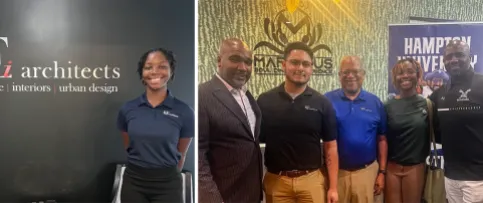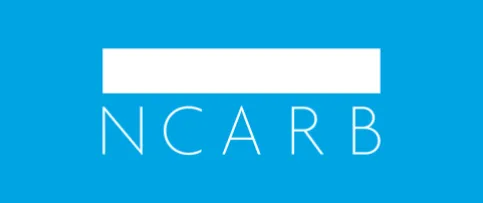The inaugural class of IPAL students, and the architects who mentored them, share how the innovative program is streamlining the path to licensure.
Washington, DC—In May, three students from the University of Florida’s CityLab-Orlando Integrated Path to Architectural Licensure (IPAL) option became the first to meet national requirements for licensure while earning a degree. As IPAL graduates, Justin Jablonski, Michael Germano, and Phillip Lantry—who each earned a Master of Architecture—will receive their license just weeks after commencement.
Created by the National Council of Architectural Registration Boards (NCARB), IPAL enables accredited programs to incorporate experience and examination requirements— known as the Architectural Experience Program® (AXP™) and Architect Registration Examination® (ARE®) 5.0—into curricula. By overlapping these three licensure requirements, the initiative aims to streamline and shorten the path to becoming an architect—without compromising the rigor needed to protect the public’s safety.
“The IPAL program is one of the most significant changes in architectural education,” said CityLab-Orlando Program Director Frank M. Bosworth, Ph.D., AIA. “Students who are looking to come to architecture school like the idea of becoming a professional upon graduation.”
Streamlining the Path to Licensure
When NCARB first began exploring the IPAL concept in 2013, becoming an architect took an average of 14 years—from the time a student enrolled in school to the moment they received a license. Currently, earning a license typically takes just over 12 years; in part, because emerging architects are already overlapping their education, experience, and examination requirements in increasing numbers. This change has been facilitated by NCARB’s work with licensing boards and architect volunteers to streamline its programs, enabling candidates to navigate licensure in a way that fits their lifestyle.
“IPAL students are exceptionally driven, eager to learn, and committed to earning a license,” said NCARB President Gregory L. Erny, FAIA, NCARB, who attended the graduation ceremony. “It’s not a one-size-fits-all world anymore. Through IPAL, schools and state licensing boards can offer an alternative path to licensure to a new and diverse pool of people.”
Justin Jablonski, the country’s first IPAL alum to complete the ARE and AXP before graduation, says he was drawn to the program’s flexibility—particularly as a father of two young children. “IPAL was appealing because I could maintain full-time employment, earn all of my experience hours, and sit for the ARE while in school. I enjoyed every minute of my experience in the program.”
Bosworth, who is both an educator and practitioner, also emphasized the program’s role in strengthening the relationship between academia and local firms. “IPAL really reinforces the idea of how powerful education can be in shaping a profession. [The program] requires a tremendous amount of personal discipline and organization, but it’s an extraordinary way to learn.”
The Benefit of Hiring IPAL Students
Since IPAL launched in 2015, NCARB has accepted 26 programs at 21 colleges from around the country. And many architecture firms are learning the benefits of hiring IPAL students. In fact, two of the graduates plan to stay at the Florida firms where they worked during school.
“As a firm, it’s important to invest in the next generation of architects,” said Nathan Butler, FAIA, Orlando Office Director at HKS Architects, Inc. “We have seen a huge benefit to hiring IPAL students like Phillip Lantry. As much as we are teaching and mentoring students, we are also learning from them.”
Lantry, who worked in the construction industry before enrolling at City-Lab Orlando, acknowledges that enrolling in an IPAL option is challenging, yet rewarding. “Balancing the three [components of licensure] was difficult, but I just decided at some point that I wanted to live and breathe architecture,” he said. “I feel very fortunate to have been able to benefit from the IPAL program.”
By providing a holistic approach to earning a degree, gaining professional experience, and taking ARE 5.0, IPAL ultimately allows students to jumpstart their careers. When researching potential schools, Michael Germano said he was looking for a program that would support his professional goals. “CityLab encouraged us to press forward and earn our licenses as soon as possible,” he said. “The economy could turn, but with a license, you will always have the ability to create work for yourself—to revitalize and redefine your career.”
Following in the footsteps of Jablonski, Germano, and Lantry, several IPAL students at North Carolina State University graduated in late-May.
To learn more about IPAL, visit www.ncarb.org/IPAL.
#####
About
The National Council of Architectural Registration Boards’ membership is made up of the architectural registration boards of all 50 states as well as those of the District of Columbia, Puerto Rico, Guam, and the U.S. Virgin Islands. NCARB assists its member registration boards in carrying out their duties and provides a certification program for individual architects.
NCARB protects the public health, safety, and welfare by leading the regulation of the practice of architecture through the development and application of standards for licensure and credentialing of architects. In order to achieve these goals, the Council develops and recommends standards to be required of an applicant for architectural registration; develops and recommends standards regulating the practice of architecture; provides to Member Boards a process for certifying the qualifications of an architect for registration; and represents the interests of Member Boards before public and private agencies. NCARB has established reciprocal registration for architects in foreign countries.
Visit: ncarb.org
Twitter: twitter.com/ncarb
Facebook: facebook.com/NCARB
YouTube: youtube.com/NCARBorg





